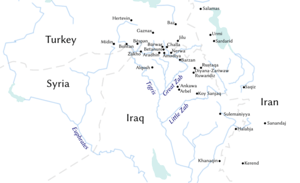Northeastern Neo-Aramaic
Northeastern Neo-Aramaic (often abbreviated NENA) is a variety of Modern Aramaic languages once spoken in a large region stretching from the plain of Urmia, in northwestern Iran, to the plain of Mosul, in northern Iraq, as well as bordering regions in south east Turkey and north east Syria.[2]

| Northeastern Neo-Aramaic | |
|---|---|
| NENA | |
| Geographic distribution | Traditionally spoken northeast to the plain of Urmia in Iran, southeast to the plain of Mosul in Iraq, southwest to Al-Hasakah Governorate in Syria and as northwest as Tur Abdin in Turkey. Diaspora speakers in North America, Europe and Israel (the Jewish dialects). |
| Linguistic classification | Afro-Asiatic
|
| Subdivisions |
|
| Glottolog | nort3241[1] |
As of the 1990s, the NENA group had an estimated number of fluent speakers among the Assyrians just below 500,000, spread throughout the Middle East and the Assyrian diaspora. More than 90% of these speak either the Assyrian Neo-Aramaic or the Chaldean Neo-Aramaic variety, two varieties of Christian Neo-Aramaic or Sureth which, contrary to what their names suggest, are not divided among denominational Chaldean Catholic Church/Assyrian Church of the East lines, and indeed some speakers of both dialects may be followers of the Syriac Orthodox Church or Protestants. There are a number of other NENA varieties, but all of them are endangered or near-extinct, and in addition, some Assyrian communities speak Central Neo-Aramaic dialects such as Turoyo.[4][5]
Influences
The NENA languages contain a large number of loanwords and some grammatical features from the extinct East Semitic Akkadian language of Mesopotamia (the original language of the Assyrians) and also in more modern times from their surrounding languages: Kurdish, Arabic, Persian, Azerbaijani and Turkish language. These languages are spoken by both Jews and Christian Assyrians from the area. Each variety of NENA is clearly Jewish or Assyrian.
However, not all varieties of one or other religious groups are intelligible with all others of the group. Likewise, in some places Jews and Assyrian Christians from the same locale speak mutually unintelligible varieties of Aramaic, where in other places their language is quite similar. The differences can be explained by the fact that NENA communities gradually became isolated into small groups spread over a wide area, and some had to be highly mobile due to various ethnic and religious persecutions.
The influence of classical Aramaic varieties — Syriac on Christian varieties and Targumic on Jewish communities — gives a dual heritage that further distinguishes language by faith. Many of the Jewish speakers of NENA varieties, the Kurdish Jews, now live in Israel, where Neo-Aramaic is endangered by the dominance of Modern Hebrew. Many Christian NENA speakers, who usually are Assyrian, are in diaspora in North America, Europe, Australia, the Caucasus and elsewhere, although indigenous communities remain in northern Iraq, south east Turkey, north east Syria and north west Iran, an area roughly comprising what had been ancient Assyria.[6]
Grouping
Blench (2006) considers Eastern Neo-Aramaic, including Neo-Mandaic, to be a single language, contrasting with Central (Turoyo) and Western Neo-Aramaic.[7] SIL Ethnologue assigns ISO codes to twelve NENA varieties, two of them extinct:
- Neo-Syriac [syr] (Sooreth, Suret, Soorath, Soorith, Suras, Sureth), historically derived from the dialect of the Lake Urmia region, now mostly spoken in Iranian Azerbaijan and northern Iraq.
- Assyrian Neo-Aramaic [aii], 235,000 speakers (1994)[8]
- Chaldean Neo-Aramaic [cld], 216,000 speakers (1994)
- Judeo-Aramaic varieties, spoken by Jewish communities in Israel
- Barzani Jewish Neo-Aramaic [bjf] (Israel), extinct
- Hulaulá or Judeo-Aramaic [huy], 10,000 speakers (1990s)
- Jewish Assyrian Neo-Aramaic (Iraq, Iran, Turkey)
- Lishana Deni [lsd] 7,500 speakers (1990s)
- Lishán Didán [trg], 4,500 speakers (2000)
- Lishanid Noshan [aij], 2,200 speakers (1990s)
- Bohtan Neo-Aramaic [bhn] (Georgia), 1,000 speakers (1990s)
- Hértevin [hrt] (Turkey), 1,000 speakers (1990s)
- Koy Sanjaq Surat [kqd] (Iraq), 900 speakers (1990s)
- Senaya [syn] (Iran), 460 speakers (1990s)
References
- Hammarström, Harald; Forkel, Robert; Haspelmath, Martin, eds. (2017). "North-Eastern Neo-Aramaic". Glottolog 3.0. Jena, Germany: Max Planck Institute for the Science of Human History.
- Bird, Isabella, Journeys in Persia and Kurdistan, including a summer in the Upper Karun region and a visit to the Nestorian rayahs, London: J. Murray, 1891, vol. ii, pp. 282 and 306
- Ariel Gutman (2018). Attributive constructions in North-Eastern Neo-Aramaic (pdf). Berlin: Language Science Press. doi:10.5281/zenodo.1182527. ISBN 978-3-96110-081-1.
- The Nestorians and their Rituals; George Percy Badger.
- A Short History of Syriac Christianity; W. Stewart McCullough.
- Heinrichs, Wolfhart (ed.) (1990). Studies in Neo-Aramaic. Scholars Press: Atlanta, Georgia. ISBN 1-55540-430-8.
- Blench, 2006. The Afro-Asiatic Languages: Classification and Reference List
- http://www.ethnologue.com/18/language/aii/